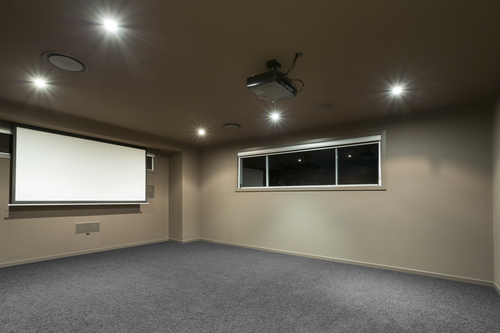If done correctly, a home theater installation can be a great addition and a fantastic upgrade to your house. Also, with the prices of movie snacks, tickets, peak-hour traffic, and the inconveniences and hassles that come with going to the theater, you’re most likely better off having a movie night in the comfort of your home.
Setting up a home entertainment system, however, requires an investment of time and money. Simply mounting a massive TV on a wall and getting surround sound speakers is not going to cut it. To properly enhance your in-home movie-watching movie experience, you’ll need the know-how and tools. With today’s home theater innovations, you can go the DIY route with a home theater installation. And if you are going to DIY your home theater or you’re shopping for home theater components; it’s good to know the common pitfalls to avoid.
Picking a Room

Picking the right room will largely contribute to your home viewing experience. Select a room in your house that is easily wired so that you can have the most excellent audio and video quality. Concerning lighting that comes in, pick a rectangular or square room with minimal to no natural light. When it comes to size, it should be big enough to accommodate a comfortable seating layout. It should also be spacious enough for having the right viewing distance from the screen. The location of the room in your house should also be where there’s not a lot of sound coming from the outside.
Selecting Speakers
The surround sound speakers serve as the heart of your home theater. People often make the mistake of getting the most expensive set of speakers, rather than getting ones that are a perfect match for their home theater setup. Another utterly wrong assumption is that you can do away without speakers, especially for those who are short on space; this line of thinking could not be further from the truth.
If you have a small room, getting a substantial floor-standing speaker is not the way to go. Big speakers in a small room will not only take up space but will also not produce good sound quality. Good thing speakers are available in different shapes and sizes to fit how big or small your room is. Consider the size of the room before getting a sound system for your home media room.
Don’t Cut Corners on Wiring
One of the usual mistakes you can make doing a home theater installation is ignoring the need for the appropriate home theater wiring accessories. If the speakers are the heart of your home theater, the connection cables, speaker wires, and surge protectors are the veins that transport power and life through the system. People believe that the wires that come with the equipment are enough. If you are looking for longer and better protection, get wiring accessories that are heavy duty.
With that being said, you don’t have to spend hundreds of dollars on wiring. Don’t get HDMI cables just because they’re expensive. As for speakers, buying 16 or 18 thickness wires. A low-cost surge protector won’t probably survive a power surge and will end up damaging your home theater investment. Spend the right amount of money on the proper safety wiring equipment. Also, ensure that there is no live wire exposed beneath the seats or other surfaces.
Getting a Screen
Getting a huge screen undoubtedly amplifies your home viewing experience. To get the most out of a TV or a display screen in your home theater, you should know the right viewing angles and distances.
Depending on the size of the monitor, the viewing distance should be about 1.6 times of the TV or display screen. Say, for instance, you have a 55” TV. The seats should be placed at a distance of 88”. You should also take into account the type of resolution of the screen; the resolution will start losing depending on the particular viewing space. Measure the width, length, and height of the screen and the space of the room you’re able to provide.
Don’t Ignore the User Manuals

Many of us leaf through the user manuals that come with electronics equipment we get. Even though it may seem like a mundane and simple task, understanding the user manuals can also contribute to the success of your home theater installation. If there is something you can’t quite comprehend, don’t hesitate to consult professional home theater installers.
